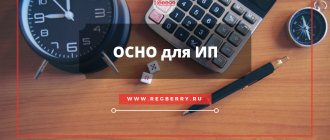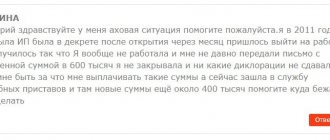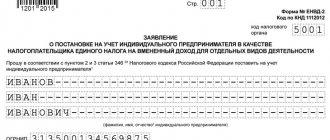In some situations, small businesses cannot be in the same tax regime . The reason is that each of the taxation systems is applied by a small business entity in relation to certain types of activities and subject to compliance with the requirements prescribed by law. Sometimes a situation arises when a small business entity performs work and provides services that fall under different tax regimes. The Tax Code allows the use of several taxation systems at once, but with certain restrictions. Which ones? Let's look at it in detail in our article...
Types of tax regimes that can be combined
Currently, there are several special tax regimes . Their differences lie in the areas of activity of potential taxpayers, their expected income and the number of employees, as well as in factors such as restrictions, validity periods, administration subtleties and others.
There are currently four special tax regimes for small businesses :
1) taxation system for agricultural producers (unified agricultural tax - Unified Agricultural Tax);
2) simplified taxation system (STS);
3) taxation system in the form of a single tax on imputed income for certain types of activities (UTII);
4) patent taxation system (PTS).
Tax systems
In the Russian Federation there are several taxation systems that taxpayers can apply.
Here are all the systems: (click to expand)
- The very first and main system is General. When an entrepreneur or founders register their activities, they initially apply this regime by default.
- Simplified is a system that replaces the payment of several taxes with one - a tax when applying the simplified tax system. There may be two objects of taxation - income or the difference between income and expenses. You can switch to the “simplified” system immediately upon registering a business entity (within the first 30 days you must submit a notice of transition) or from the beginning of the new year.
- UTII is a system that replaces the payment of certain taxes with a tax on imputed activities. It does not depend on the financial result of the activity, but is calculated based on the imputed income established by the state. You can switch at any time. To do this, within five days from the date of commencement of activities subject to this tax, you need to send an application to the tax office for registration.
- The patent taxation system is a system that can only be used by individual entrepreneurs. The good thing is that after paying for a patent, you don’t need to file a declaration. The patent is calculated by the state and does not depend on the income and expenses of the entrepreneur.
- The Unified Agricultural Tax is a system intended for agricultural producers. This is a reduced tax rate and a replacement for the Unified Agricultural Tax of some other taxes. Very convenient for organizations and entrepreneurs involved in agriculture.
Combination of tax regimes table
At the same time, it should be noted that there are certain nuances when combining different taxation systems. For clarity, we display them in Table 1.
Table 1 - Combination of different taxation systems
Special tax regimes for legal entities replace the payment of corporate income tax and corporate property tax with a single tax. In addition, taxpayers applying special tax regimes are not recognized as VAT taxpayers (with the exception of certain cases).
For individual entrepreneurs, a single tax replaces the payment of personal income tax, VAT and property tax for individuals in relation to property used in business activities.
Special tax regimes have a stimulating effect on the economy, as they provide for a reduction in the tax burden of the taxpayer. Thanks to their use, not only the fiscal, but also the regulatory function of the country’s tax system is implemented.
Organizations that only carry out primary and subsequent processing of agricultural products do not have the right to apply the Unified Agricultural Tax. This system replaces corporate income tax, corporate property tax and VAT.
To switch to the Unified Agricultural Tax, there is one condition - income from agricultural activities must be at least 70%.
Organizations and individual entrepreneurs engaged in the production of excisable goods, organizations operating in the field of gambling, as well as budgetary, state-owned and autonomous institutions also use a special taxation regime. The object of taxation is income reduced by the amount of expenses incurred. Tax rate 6%.
The most commonly used taxation regime is the one called “simplified taxation”. Like other special tax regimes, the simplified tax system is applied by small businesses on a voluntary basis. However, tax legislation contains a set of restrictions for application in the simplified tax system.
To apply the simplified tax regime in small businesses, there are a large number of restrictions that must be taken into account. Therefore, at the moment, most companies do not seek to switch to such a regime and use the traditional tax regime.
The choice of a simplified tax system is made by accurately establishing the number of employees of the company (no more than 100 people), the residual value of fixed assets (no more than 150 million rubles) and annual revenue (no more than 150 million rubles).
What is the simplified tax system and who can use it
The simplified taxation system is one of the special regimes provided for by law. It is available to entrepreneurs and legal entities, but only subject to the conditions of Art. 346.13 Tax Code of the Russian Federation:
- no more than 100 employees;
- annual income up to 150 million rubles;
- residual value of fixed assets up to 150 million rubles;
- the share of other legal entities in the authorized capital is 25%;
- type of activity not prohibited by Art. 346.12 Tax Code of the Russian Federation;
- lack of branches.
Simplified people pay one tax instead of the three that they have to pay on OSNO (income tax, VAT and property tax). All other taxes are paid in the same way as OSNO. At the same time, the simplified tax system makes calculations easier and the tax burden is lower. The tax rate depends on the selected tax object:
- the difference between income and expenses - 15%;
- income - 6%.
Local authorities may reduce rates even further, check with your tax office about this.
Another advantage of the simplified tax system over OSNO is the ability to deduct insurance premiums for employees and individual entrepreneurs and reduce taxes. Under the simplified tax system “Income”, insurance premiums of organizations and individual entrepreneurs with employees can reduce the tax base by 50%, contributions of individual entrepreneurs without employees - by 100%.
Keep records of exports and imports in the Kontur.Accounting web service. Simple accounting, payroll and reporting in one service
Possible combinations of tax regimes
Possible combinations of tax regimes for firms are shown in Table 2.
Table 2 - Possible combinations of tax regimes for firms
| Mode | BASIC | Unified agricultural tax | simplified tax system | UTII | PSA (production sharing agreement) |
| BASIC | X | — | — | + | — |
| Unified agricultural tax | — | X | — | + | — |
| simplified tax system | — | — | X | + | — |
| UTII | + | + | + | X | — |
| PSA | — | — | — | — | X |
The possibilities of individual entrepreneurs in terms of combining taxation regimes are significantly wider than those of companies, due to the PSN, which can be used in conjunction with any other system used by the individual entrepreneur, since, as with UTII, certain types of activities are transferred to PSN. Possible combinations of tax regimes for firms are shown in Table 3.
Table 3 - Possible combinations of tax regimes for individual entrepreneurs
| Mode | BASIC | Unified agricultural tax | simplified tax system | UTII | PSN |
| BASIC | X | — | — | + | + |
| Unified agricultural tax | — | X | — | + | + |
| simplified tax system | — | — | X | + | + |
| UTII | + | + | + | X | + |
| PSN | + | + | + | + | X |
A very conditional exception could previously be considered a situation similar to that considered by the Ministry of Finance of Russia in letters dated July 18, 2014 No. 03-11-12/35437 and dated November 26, 2015 No. 03-11-12/68872. The individual entrepreneur combined the PSN and the simplified tax system, but lost the right to use the patent system before the end of the calendar year.
The transition to a simplified taxation system or a return to other taxation regimes is carried out voluntarily by organizations and individual entrepreneurs.
UTII differs from other tax regimes in that its size does not depend on the actual amount of profit of the entrepreneur. Calculated from average indicators for each type of activity. This method of taxation is more beneficial for entrepreneurs whose profitability indicators are above average in the same industry.
This type of taxation is available to organizations of certain types: retail trade; household and veterinary services; catering; distribution and (or) placement of advertising; repair, washing and maintenance services for motor vehicles; parking services.
Individual entrepreneurs whose average number of employees during the tax period for all types of business activities carried out by individual entrepreneurs does not exceed 15 people have the right to
This system does not apply to types of business activities carried out under a simple partnership agreement (joint activity agreement) or a property trust management agreement. This system replaces personal income tax, personal income tax, and VAT. The disadvantage is that such a system can only be used by individual entrepreneurs.
Today, many people prefer not to open their own business due to the confusing tax situation, as well as the need to pay significant amounts to various government bodies.
UTII and OSNO are two different tax systems that can be combined, for example, when an organization conducts several types of activities, one of which is subject to UTII and the other is not. But the simultaneous use of these two regimes requires the taxpayer to maintain separate records (clause 7 of Article 346.26 of the Tax Code of the Russian Federation). Without it, it will be impossible to correctly calculate the amount of taxes to be paid, as well as to deduct input VAT on purchased goods, works, and services (clause 4 of Article 170 of the Tax Code of the Russian Federation).
The Tax Code of the Russian Federation does not contain clear instructions on how separate accounting should be organized in an organization when combining UTII and OSNO. Each taxpayer decides this issue independently. In this case, specific methods of maintaining separate accounting must be recorded in the order on accounting policies for tax purposes.
Separate accounting of indicators when combining tax regimes
Within the framework of separate accounting, it is necessary to separately take into account indicators that are one way or another involved in the calculation of taxes. These include:
- income and expenses. UTII is calculated based on the amount of imputed income, and the payer’s actual income is not taken into account (Article 346.29 of the Tax Code of the Russian Federation). The income tax paid under OSN, on the contrary, is determined precisely on the basis of the difference between the income received and the expenses recognized in accounting (Article 247, paragraph 1 of Article 274 of the Tax Code of the Russian Federation). At the same time, the inclusion of UTII expenses in the calculation of the income tax base will lead to its underestimation and incorrect calculation of the tax. Therefore, separate accounting of income and expenses is necessary (clause 9 of Article 274 of the Tax Code of the Russian Federation);
— input VAT. Enterprises applying the general taxation regime are mostly VAT payers. And only when maintaining separate records of the amount of input VAT on transactions related to the SST, they will be able to deduct;
- property . It is obvious that separate accounting of property assets is necessary for the purposes of calculating property tax.
In addition, you will need to organize separate accounting of employees . Then it is possible to divide between modes without problems:
— labor costs . Salaries and other labor payments in favor of employees engaged only in general activities can be taken into account as expenses for profit tax purposes (Article 255, paragraph 9 of Article 274 of the Tax Code of the Russian Federation);
- insurance premiums accrued from employee payments, as well as sick leave benefits paid to them. The part of them related to OSN can again be taken into account in “profitable” expenses (clause 9 of Article 274, subclause 1 of clause 1 of Article 264 of the Tax Code of the Russian Federation), and the part related to UTII - when calculating the imputed tax (clause 2, 2.1 of article 346.32 of the Tax Code of the Russian Federation) [1].
Also, when combining UTII and the general taxation system, separate accounting of physical indicators , on the basis of which the imputed tax is calculated. This could be, for example, the number of employees. The situation becomes more complicated if the same employees are employed both in activities subject to UTII and in activities to which the SST is applied. Many imputations in such a situation divide workers in proportion to the share of revenue received under one and the other taxation regime.
The possibility of applying the simplified tax system does not depend on the type of activity carried out by the company or individual entrepreneur, but on the scale of the activity. Simplified taxation and OSNO are the basic taxation systems, which explains the impossibility of their simultaneous application.
Tax legislation does not contain a prohibition on combining the simultaneous use of three taxation regimes: simplified tax system with UTII and PSN in relation to certain types of business activities.
When applying PSN, an individual entrepreneur has the right to hire employees, including under civil contracts. At the same time, the average number of employees during the tax period should not exceed 15 people for all types of business activities carried out by an individual entrepreneur, as provided for in paragraph 5 of Article 346.43 of the Tax Code of the Russian Federation.
The scope of application of the PSN, on the contrary, is represented by a list of activities for which it is permitted (clause 2 of Article 346.43 of the Tax Code of the Russian Federation). This list can be supplemented with additional types of activities on the basis of legislative acts adopted by the constituent entities of the Russian Federation (subclause 2, clause 8, article 346.43). Therefore, when planning the transition to the PSN for certain types of activities, you should familiarize yourself not only with the list from the Tax Code of the Russian Federation, but also with the additional list of the region in which business activities are carried out.
Is it possible to combine the tax regime for construction and food products?
Organizations and entrepreneurs, if they use different types of activities, will sooner or later be forced to pay taxes using different systems and special tax regimes.
Many may be interested in the question: is it permissible to combine OSNO and simplified tax system? We will try to answer this question in this article. In our country there are taxation systems and special taxation regimes.
The first (systems - OSNO, Unified Agricultural Tax, STS) are of a general nature, they are more generalized, while the regimes are focused primarily on the type of activity (UTII), or on a specific entrepreneur.
In some cases, a combination of systems and modes is allowed if the types of activities are different. But is it possible to combine a general system and a simplified one? First, let's look at what is typical for each of them.
Is it legal to combine three taxation systems?
Important
- At the location of the unit that will conduct the relevant activities - as a general rule.
- The place of registration of the organization is for various types of traveling activities that are not tied to a specific territory (for advertising in transport, transportation, delivery trade, etc.).
Norm clause 2 art. 346.28 of the Tax Code of the Russian Federation, which states that when opening subdivisions in several localities, it is necessary to submit an application for registration only with the tax authority at the location of the subdivision listed first in the list, applies as follows.
It applies to those municipalities on the territory of which several tax authorities operate, while the normative act establishing K_2 for the special regime is single. This situation may occur in cities of federal significance.
In all other cases, this is technically impossible, because...
I want to know everything: combining tax regimes
There are practically no problems when organizing separate accounting for income. According to Art. 346.15 of the Tax Code of the Russian Federation, the simplified tax system takes into account income from sales (Article 249 of the Tax Code of the Russian Federation) and non-operating income (Article 250 of the Tax Code of the Russian Federation). Income listed in Art. 251 of the Tax Code of the Russian Federation, are not included in the tax base.
For UTII, the amount of income (as well as expenses) does not matter, since it is determined on the basis of physical indicators, basic profitability and coefficients that are established by the Tax Code and local regulations (Article 346.29 of the Tax Code of the Russian Federation).
Separate accounting of income is important only for the simplified tax system. But with expenses it is more difficult. There are indirect costs that cannot be clearly allocated to work areas, and then they are distributed in proportion to the share of income from this activity in the total income of the organization.
This rule is provided for in paragraph 8 of Art. 346.18 Tax Code of the Russian Federation.
Which taxation system is better for LLCs in 2020
Tax Code of the Russian Federation), it can be used by firms and individual entrepreneurs in relation to strictly defined one or several types of activities;
- PSA is a taxation system for the implementation of a production sharing agreement (Chapter 26.4 of the Tax Code of the Russian Federation), used in relation to all activities by one legal entity or an association of legal entities when, within the framework of an agreement, the search and production of mineral raw materials in a subsoil plot that belongs to the state;
- PSN is a patent taxation system (Chapter 26.5 of the Tax Code of the Russian Federation), applied only to individual entrepreneurs in relation to strictly defined types of activities.
Is it possible to combine the OSNO and the simplified tax system under the Tax Code of the Russian Federation? The possibility of applying the simplified tax system depends not on the type of activity carried out by the company or individual entrepreneur, but on the scale of the activity. Simplified taxation and OSNO are the basic taxation systems, which explains the impossibility of their simultaneous application.
IMPORTANT! Thus, the presence of codes corresponding to paragraph 2 of Art. 346.26 of the Tax Code of the Russian Federation, and for household services by order of the Government of the Russian Federation dated November 24, 2016 No. 2496-r, meets the interests of the taxpayer himself.
In addition, compliance of the codes will eliminate any conflicts with the tax authority regarding the possibility of using UTII by the organization.
Their presence is the most significant confirmation of the conduct of activities falling under the special regime.
Attention
If the required codes were not specified when establishing a legal entity, you can make changes to the state register information. We talked about this in the article at the link: The procedure for changing OKVED codes for LLCs in 2016-2017.
Transition to UTII in one of the areas The main option for the combined use of 2 modes is the one in which the taxpayer, immediately after registration or during work, decides to transfer one of the areas to a special regime.
Combining PSN with other tax regimes
Therefore, it is necessary to register with each of the tax authorities at the place of work of each structural unit (letter of the Federal Tax Service of the Russian Federation dated 02/05/2014 No. GD-4-3/).
If an organization creates a division in another locality and does not register it with UTII, then it applies OSNO for it.
Number of employees when applying 2 modes With OSNO there are no restrictions on the number of employees, and with UTII it is limited to 100 people.
An example of combining tax regimes for individual entrepreneurs
IP Maksimov M. M. is engaged in 2 types of activities in one city:
1) retails various pet products through a stationary store with a sales area of 100 sq. m;
2) provides veterinary services.
Revenue from all types of activities for the previous tax period amounted to 10 million rubles. There are 25 employees on staff, including 5 people at the veterinary point.
Individual entrepreneur Maksimov M. M. has the right to apply the simplified tax system for all types of activities. The transition to PSN is possible only for the type of activity specified in paragraph 2 of our list. For the activities specified in clause 1, the transition to PSN is impossible due to exceeding the permissible limit of retail space of 50 sq. m. m and the permissible number of employees according to PSN.
Individual entrepreneur Maksimov M. M., taking into account the listed conditions, has the right to combine the simplified tax system for the activities specified in clause 1 of the list with the PSN for the activities specified in clause 2.
For the same types of activities carried out at different points, but within the same constituent entity of the Russian Federation, the simultaneous use of the simplified tax system and the PSN, in the opinion of the tax department of the Russian Federation, is impossible, even if all legislative conditions for the compatibility of special regimes are met. This position is set out in the letter of the Federal Tax Service of the Russian Federation dated March 28, 2013 No. ED-3-3/1116.
Example (continued)
Individual entrepreneur M. M. Maksimov notified the Federal Tax Service of the transition to the simplified tax system for the activities specified in clauses 1 and 2, and received the appropriate permission.
During the year, in the same city, individual entrepreneur M. M. Maksimov decided to open another point for the provision of veterinary services with a staff of 3 people and submitted a notification to the Federal Tax Service about the application of PSN for the opened veterinary point.
In response, the Federal Tax Service refused to apply the PSN due to the fact that veterinary activities had already been transferred to the simplified tax system. The entrepreneur is offered to either completely transfer veterinary activities to the simplified tax system, or leave it under the simplified tax system.
At the same time, the letter of the Ministry of Finance dated 04/05/2013 No. 03-11-10/11254 allows the use of the simplified tax system and PSN for the same types of activities in the same subject, but this position cannot be applied in practice until it finds sufficient confirmation in the arbitration court.







